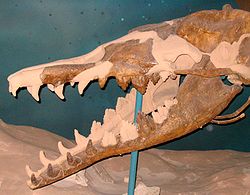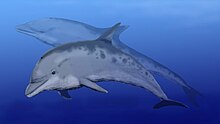List of extinct cetaceans
| Cetaceans Temporal range: Early Eocene - Recent
| |
|---|---|

| |
| A skull of Basilosaurus cetoides. | |
| Scientific classification | |
| Kingdom: | |
| Phylum: | |
| Subphylum: | |
| Class: | |
| Order: | Brisson, 1762
|
The list of extinct cetaceans features the extinct genera and species of the order Cetacea. The cetaceans (whales, dolphins and porpoises) are descendants of land-living mammals, the even-toed ungulates. The earliest cetaceans were still hoofed-mammals. These early cetaceans became gradually better adapted for swimming than for walking on land, finally evolving into fully marine cetaceans.
This list currently includes only fossil genera and species. However, the Atlantic population of Gray Whales (Eschrichtius robustus) went extinct in the 18th century, and the Baiji (or Chinese River Dolphin, Lipotes vexillifer) was declared "functionally extinct" after an expedition in late 2006 failed to find any in the Yangtze River.
Suborder Archaeoceti
Family Ambulocetidae
(Eocene)

Family Basilosauridae
(Late Eocene)

Family Pakicetidae
(Early to Middle Eocene)

Family Protocetidae
(Eocene)

Family Remingtonocetidae
(Eocene)
Suborder Mysticeti
Family Aetiocetidae
(Oligocene)

Family Llanocetidae
(Late Eocene)
Family Mammalodontidae
(jr synonym Janjucetidae)

(Late Oligocene)
Clade Chaeomysticeti
Superfamily Eomysticetoidea
Family Cetotheriopsidae
(Oligocene to Miocene)
Family Eomysticetidae
(Oligocene)
Superfamily Balaenoidea
Family Balaenidae
(Oligocene to Recent)
- Balaena
- Balaenella
- Balaenotus
- Balaenula
- Eubalaena (extant)
- Idiocetus
- Morenocetus
- Peripolocetus
- Protobalaena
Family Neobalaenidae
(Miocene to Recent)
Clade Thalassotherii
Family Aglaocetidae
(Miocene to Pliocene)
Family Balaenopteridae
(Oligocene to Recent)
- Archaebalaenoptera
- Balaenoptera (extant)
- Burtinopsis
- Cetotheriophanes
- Parabalaenoptera
- Plesiobalaenoptera
- Plesiocetus
- Praemegaptera
- Protororqualus
Family Cetotheriidae
(Miocene - Recent)
Classification follows Steeman, 2007.[5]

- Brandtocetus
- Cephalotropis
- Cetotherium
- Eucetotherium
- Herpetocetus
- Hibacetus[6]
- Joumocetus[7]
- Kurdalagonus
- Metopocetus
- Mixocetus[8]
- Nannocetus

Parietobalaena palmeri skull - Piscobalaena[9]
- Titanocetus[10]
- Vampalus
Family Diorocetidae
(Miocene to Pliocene)
Family Eschrichtiidae
(Miocene to Recent)
- Archaeschrichtius
- Eschrichtioides
- Eschrichtius (extant)
- Gricetoides
- Megapteropsis
Family Pelocetidae
(Miocene)
Family incertae sedis

- Eobalaenoptera (Middle Miocene; Mysticeti)
- Imerocetus (Late Miocene; Chaeomysticeti
- Mioceta
- Otradnocetus (Middle Miocene; Chaeomysticeti)
- Piscocetus (Pliocene; Chaeomysticeti)
- Siphonocetus
- Tiphyocetus (Miocene, Chaeomysticeti)
- Tretulias
- Ulias
Suborder Odontoceti
Basal forms
Family Agorophiidae
(Late Oligocene)
Family Patriocetidae
(Oligocene to Early Miocene)
Family Simocetidae
(Late Oligocene)
Family Xenorophidae
(Oligocene)
Superfamily Delphinoidea
Family Albireonidae
(Miocene to Pliocene)
Family Delphinidae

(Oligocene to Recent)
- Anacharsis
- Arimidelphis
- Astadelphis
- Australodelphis
- Delphinus (extant)
- Etruridelphis
- Globicephala (extant)
- Hemisyntrachelus
- Lagenorhynchus (extant)
- Orcinus (extant)
- Protoglobicephala
- Pseudorca (extant)
- Septidelphis[11]
- Stenella (extant)
- Tursiops (extant)
Family Kentriodontidae
(Late Oligocene - Middle Miocene)

- Subfamily Kentriodontinae
- Genus Belonodelphis
- Genus Delphinodon
- Genus Incacetus
- Genus Kentriodon
- Genus Macrokentriodon
- Genus Microphocaena
- Genus Rudicetus
- Genus Tagicetus
- Subfamily Lophocetinae
- Genus Hadrodelphis
- Genus Liolithax
- Genus Lophocetus
- Subfamily Pithanodelphininae
- Genus Atocetus
- Genus Leptodelphis
- Genus Pithanodelphis
- Genus Sophianacetus
- Subfamily incertae sedis
- Genus Sarmatodelphis
- Genus Kampholophos
Family Monodontidae
(Miocene to Pliocene)
Family Odobenocetopsidae
(Pliocene)

Family Phocoenidae
(Miocene to Recent)
- Archaeophocaena
- Australithax
- Haborophocoena
- Lomacetus
- Loxolithax
- Miophocaena
- Numataphocoena
- Piscolithax
- Pterophocaena
- Salumiphocaena
- Semirostrum[12]
- Septemriocetus
Family incertae sedis
- Delphinavus
- Graamocetus
- Lamprolithax
- Miodelphis
- Nannolithax
- Oedolithax
- Oligodelphis
- Palaeophocaena
- Platylithax
- Prionodelphis
- Protodelphinus
- Sinanodelphis
Superfamily Inioidea
Family Iniidae
Family Pontoporiidae
(Middle Miocene to Recent)
Superfamily Lipotoidea
Family Lipotidae
(Miocene to Recent)
Superfamily Physeteroidea
Family Kogiidae
(Miocene to recent)
- Aprixokogia
- Kogia (extant)
- Kogiopsis
- Praekogia
- Scaphokogia
- Thalassocetus
Family Physeteridae
- Aulophyseter
- Diaphorocetus
- Ferecetotherium
- Helvicetus
- Hoplocetus
- Idiophyseter
- Idiorophus
- Orycterocetus
- Physeter (extant)
- Physeterula
- Placoziphius
- Preaulophyseter
Family incertae sedis
- Acrophyseter
- Brygmophyseter
- Eudelphis
- Livyatan[13]
- Paleophoca
- Placoziphius
- Prophyseter
- Scaldicetus
- Zygophyseter
Superfamily Platanistoidea
Family Allodelphinidae
(Early to Middle Miocene)
Family Dalpiazinidae
(Late Oligocene to Miocene)
Family Platanistidae
(Miocene to Recent)
Family Prosqualodontidae
(Oligocene to Miocene)
Family Squalodelphinidae
(Early to Late Miocene)
- Medocinia
- Notocetus (syn. Argyrodelphis, Diochotichus)
- Phocageneus
- Squalodelphis
Family Squalodontidae
(Oligocene to Pliocene)
- Eosqualodon
- Macrophoca
- Pachyodon
- Phoberodon
- Squalodon (syn. Kelloggia, Rhizoprion, Crenidelphinus, Arionius, Phocodon)
- Smilocamptus
- Tangaroasaurus
Family Waipatiidae
(Oligocene)
Superfamily Ziphioidea
Family Eoplatanistidae
(Miocene)
Family Eurhinodelphinidae
(Mid Miocene to Pliocene)

- Argyrocetus
- Ceterhinops
- Eurhinodelphis
- Iniopsis
- Macrodelphinus
- Mycteriacetus
- Phocaenopsis
- Rhabdosteus
- Schizodelphis
- Squaloziphius
- Vanbreenia
- Xiphiacetus
- Ziphiodelphis
Family Ziphiidae
(Miocene to Recent)
Classification after Bianucci et al. 2013[15]
- Basal forms
- Subfamily Berardiinae
- Subfamily Hyperoodontinae
- Africanacetus
- Ihlengesi
- Mesoplodon (extant)
- Subfamily Ziphiinae
- Subfamily incertae sedis
Family incertae sedis
- Agriocetus
- Atropatenocetus (Oligocene)
- Austrosqualodon (Oligocene)
- Hesperocetus
- Imerodelphis (Miocene)
- Kharthlidelphis
- Lonchodelphis
- Microsqualodon
- Microzeuglodon
- Mirocetus
- Neosqualodon
- Pelocetus
- Pontivaga
- Papahu (Miocene)[16]
- Saurocetus (Oligocene)
See also
References
- ^ http://deepblue.lib.umich.edu/bitstream/2027.42/57499/1/Vol%2031%20No%2013%20final%2012-19-07.pdf
- ^ Gingerich, P.D. et al. 2001. Origin of Whales from Early Artiodactyls: Hands and Feet of Eocene Protocetidae from Pakistan. (19 September 2001). Science doi:10.1126/science.1063902.
- ^ Philip D. Gingerich and Henri Cappetta (2014). "A New Archaeocete and Other Marine Mammals (Cetacea and Sirenia) from Lower Middle Eocene Phosphate Deposits of Togo". Journal of Paleontology. 88 (1): 109–129. doi:10.1666/13-040.
- ^ "A new marine vertebrate assemblage from the Late Neogene Purisima Formation in Central California, part II: Pinnipeds and Cetaceans". Geodiversitas. 35 (4): 815–940. 2013.
{{cite journal}}: Unknown parameter|authors=ignored (help) - ^ M. E. Steeman (2007). "Cladistic analysis and a revised classification of fossil and recent mysticetes". Zoological Journal of the Linnean Society. 150 (4): 875–894. doi:10.1111/j.1096-3642.2007.00313.x.
{{cite journal}}: Cite has empty unknown parameter:|month=(help) - ^ Otsuka, H.; Ota, Y. (2008). "Cetotheres from the early Middle Miocene Bihoku Group in Shobara District, Hiroshima Prefecture, West Japan". Miscellaneous Reports of the Hiwa Museum for Natural History. 49 (2): 1–66.
- ^ Kimura, T.; Hasegawa, Y. (2010). "A new baleen whale (Mysticeti: Cetotheriidae) from the earliest late Miocene of Japan and a reconsideration of the phylogeny of cetotheres". Journal of Vertebrate Paleontology. 30 (2): 577–591. doi:10.1080/02724631003621912.
- ^ Kellogg, R. (1934). "A new cetothere from the Modelo Formation at Los Angeles, California". Carnegie Institution of Washington. 447: 83–104.
- ^ Bouetel, V.; Muizon, C. de (2006). pdf "The anatomy and relationships of Piscobalaena nana (Cetacea, Mysticeti), a Cetotheriidae s.s. from the early Pliocene of Peru". Geodiversitas. 28 (2): 319–395.
{{cite journal}}: Check|url=value (help) - ^ Bisconti, M. (2006). "Titanocetus, a new baleen whale from the middle Miocene of northern Italy (Mammalia, Cetacea, Mysticeti)". Journal of Vertebrate Paleontology. 26 (2): 344–354. JSTOR 4524574.
- ^ Giovanni Bianucci (2013). "Septidelphis morii, n. gen. et sp., from the Pliocene of Italy: new evidence of the explosive radiation of true dolphins (Odontoceti, Delphinidae)". Journal of Vertebrate Paleontology. 33 (3): 722–740. doi:10.1080/02724634.2013.744757.
- ^ Rachel A. Racicot, Thomas A. Deméré, Brian L. Beatty, Robert W. Boessenecker. Unique Feeding Morphology in a New Prognathous Extinct Porpoise from the Pliocene of California. Current Biology, 13 March 2014 DOI: 10.1016/j.cub.2014.02.031
- ^ Lambert, O., G. Bianucci, K. Post, C. de Muizon, R. Salas-Gismondi, M. Urbina & J. Reumer. (2010). The giant bite of a new raptorial sperm whale from the Miocene epoch of Peru. Nature 466: 105–108. doi:10.1038/nature09067
- ^ Fitzgerald, E.M.G. 2004. A review of the Tertiary fossil Cetacea (Mammalia) localities in Australia. Memoirs of Museum Victoria 61(2): 183-208.
- ^ O. Lambert, C. Muizon, and G. Bianucci. 2013. The most basal beaked whale Ninoziphius platyrostris Muizon, 1983: clues on the evolutionary history of the family Ziphiidae (Cetacea: Odontoceti). Zoological Journal of the Linnean Society 167:569-598
- ^ Gabriel Aguirre-Fernández and R. Ewan Fordyce (2014). "Papahu taitapu, gen. et sp. nov., an early Miocene stem odontocete (Cetacea) from New Zealand". Journal of Vertebrate Paleontology. 34 (1): 195–210. doi:10.1080/02724634.2013.799069.


